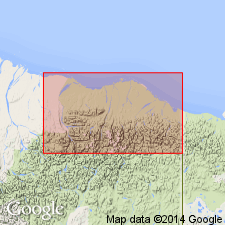
- Usage in publication:
-
- Hue Shale*
- Modifications:
-
- Named
- Biostratigraphic dating
- Dominant lithology:
-
- Shale
- Bentonite
- Tuff
- AAPG geologic province:
-
- Alaska Northern region
Summary:
Named for exposures along ridge immediately west of Hue Creek. Type section designated as these exposures at base of Shublik Mountains on south side of Ignek Valley, NE/4 sec.6 T2N R26E, northern AK. Previously rocks were assigned to Shale Wall member of Seabee Formation or included in lower part of the "shale of Colville Group" of Molenaar (1983, p.1074). Crops out on both sides of Sadlerochit Mountains and in Jago and Niguanak River areas on coastal plain. Also occurs throughout subsurface of coastal plain and can be traced in coastal wells as far west as Colville River. Composed of shale, bentonite, and tuff. Is 730 ft (222 m) thick at type section, although fault cuts out part of section. Is as thick as 1000 ft (300 m) in West Staines State-2 well. Conformably overlies pebble shale unit; unconformably underlies Canning Formation (new) Based on paleontological evidence age is Aptian(?) (Early Cretaceous) to Campanian or Maestrichtian (Late Cretaceous) in most outcrops and may be Paleocene in subsurface in northern part of ANWR.
Source: GNU records (USGS DDS-6; Menlo GNULEX).
For more information, please contact Nancy Stamm, Geologic Names Committee Secretary.
Asterisk (*) indicates published by U.S. Geological Survey authors.
"No current usage" (†) implies that a name has been abandoned or has fallen into disuse. Former usage and, if known, replacement name given in parentheses ( ).
Slash (/) indicates name conflicts with nomenclatural guidelines (CSN, 1933; ACSN, 1961, 1970; NACSN, 1983, 2005, 2021). May be explained within brackets ([ ]).

